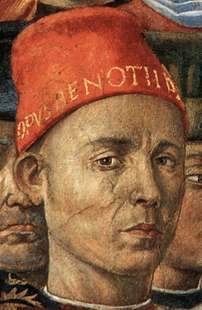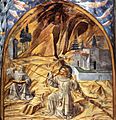Benozzo Gozzoli facts for kids
Quick facts for kids
Benozzo Gozzoli
|
|
|---|---|

Self-portrait from fresco Procession of the Magi
|
|
| Born |
Benozzo di Lese
c. 1421 Sant'Ilario a Colombano, Republic of Florence
|
| Died | 4 October 1497 Pistoia, Republic of Florence
|
| Nationality | Florentine |
| Known for | Painting, Fresco |
| Movement | Early Renaissance |
Benozzo Gozzoli (born around 1421, died 1497) was a famous Italian painter from Florence. He lived during the exciting time of the Renaissance. Benozzo was a student of another great artist, Fra Angelico. He is most famous for his amazing wall paintings, called frescoes.
His most well-known works are the murals in the Magi Chapel of the Palazzo Medici-Riccardi. These paintings show lively parades with lots of detail. They also show a new interest in nature and realistic people. Gozzoli was one of the busiest fresco painters of his time. He worked mostly in Tuscany, but also in Umbria and Rome.
Contents
Biography
Early Life and Training
Benozzo Gozzoli was born Benozzo di Lese. His father was a tailor. He was born in a village called Sant'Ilario a Colombano around 1421. His family moved to nearby Florence in 1427.
A writer from the 1500s, Giorgio Vasari, said that Gozzoli was a student and helper of Fra Angelico. This was early in Benozzo's career.
Working with Fra Angelico
Benozzo helped Fra Angelico paint frescoes in the Convent of San Marco in Florence. Some of his contributions include The Adoration of the Magi and Women at the Tomb. Like many artists of his time, Benozzo first trained as a goldsmith and then as a painter.
From 1444 to 1447, he worked with Lorenzo Ghiberti. They helped create the famous Gates of Paradise for the Florence Baptistery.
In 1447, Benozzo went to Rome with Fra Angelico. They were called by Pope Eugene IV to paint frescoes in the Vatican Palace. These paintings are now gone. Then, they went to Umbria and decorated a chapel in the Orvieto Cathedral.
They only finished part of the chapel because they were called back to the Vatican. There, they worked for Pope Nicholas V until 1448. Gozzoli likely helped a lot with the frescoes in the Niccoline Chapel. He also painted a fresco of St Anthony of Padua in Rome.
Fra Angelico and Lorenzo Ghiberti greatly influenced Gozzoli's art. Ghiberti taught him to be very precise with details. Fra Angelico taught him to use bright colors in his frescoes.
Working in Umbria
In 1449, Gozzoli left Angelico and moved to Umbria. In the town of Narni, he painted an Annunciation in 1450. He signed this work. In the monastery of San Fortunato, near Montefalco, Gozzoli painted a Madonna and Child between St. Francis and St. Bernardine of Siena. He also painted two other works there. One of these, the Madonna of the Girdle, is now in the Vatican Museums. It shows how similar Benozzo's early style was to Angelico's.
In 1450, Gozzoli got his first big independent job. He painted the choir chapel in the monastery of S. Francesco in Montefalco. He filled it with scenes from the life of St Francis of Assisi. He also included portraits of famous people like Dante and Giotto. These works were finished in 1452. They still show Angelico's style, but also some influence from Giotto.
Gozzoli likely stayed in Montefalco until 1456. He then went to Perugia and painted a Virgin and Saints. This painting is now in a local art academy.
Return to Florence
In 1456, Benozzo came back to his home city of Florence. Florence was a very important art center at that time. Between 1459 and 1461, Gozzoli painted his most famous works. These are the frescoes in the Magi Chapel of the Palazzo Medici-Riccardi.
The Magi Chapel Frescoes
In his Journey of the Magi to Bethlehem and Angels in Adoration, he showed great skill. He combined complex scenes with subtle details. He painted a rich scene with realistic nature and vivid portraits of people. Gozzoli included many portraits of his patrons, the Medici family. He also painted his own self-portrait in the procession. You can see his name written on his cap.
His frescoes in the Magi Chapel made Gozzoli very famous. This led to new and important jobs. One of these was an altarpiece for a group in Florence. He painted The Virgin and Child Enthroned among Angels and Saints between 1461 and 1462. This painting is now in the National Gallery, London.
Later Years in Tuscany
San Gimignano
In 1463, Gozzoli left Florence for San Gimignano. He probably left because he was afraid of the plague. There, he created many large works. The most important is his seventeen-panel fresco series. It shows The Life of St Augustine. This covers the entire chapel in the church of Sant'Agostino.
In the same church, Gozzoli also painted St. Sebastian Protecting the City from the Plague. In this painting, St. Sebastian is fully clothed and unharmed. This was unusual for paintings of St. Sebastian. In 1465, Gozzoli also painted a fresco of the Martyrdom of Sebastian in the Collegiate Church. He stayed in San Gimignano until 1467. He completed more works in the city and nearby areas.
Pisa
In 1469, Gozzoli moved to Pisa. He started his biggest project there. This was a huge series of wall paintings in the Campo Santo building in Pisa. He painted twenty-four scenes from the Old Testament. These included The Invention of Wine by Noah and The Visit of the Queen of Sheba to Solomon.
He was supposed to paint three scenes per year. However, he painted only three pictures in two years. This might be because he included so many figures and details. By 1470, he had painted Noah and his Family and the Building of the Tower of Babel. The Tower of Babel painting includes portraits of Cosimo de' Medici and the young Lorenzo.
All this huge amount of work took sixteen years, lasting until 1485. This is the last known date for any of his works. Gozzoli died in Pistoia in 1497, possibly from a sickness. In 1478, the people of Pisa gave him a tomb in the Campo Santo as a sign of their respect. He also owned a house in Pisa and land in Florence.
Trivia
- The painters Francesco, Gerolamo, and Alesso di Benozzo were his sons. They helped him with many of his painting jobs.
- The "Master of the Small Figures" is another name for a painter called "Alunno di Benozzo" (pupil of Benozzo). This name is based on their painting style.
Major work
- Women at the Tomb (1440–1441) - Fresco, San Marco, Florence
- Adoration of the Magi (1440–1441) - Fresco, San Marco, Florence
- Gates of Paradise (1444-1447, collaboration) - Gilded bronze doors, Museo dell'Opera del Duomo, Florence
- Chapel of the Madonna di San Brizio (1447, collaboration) - Fresco, Orvieto Cathedral, Orvieto
- Niccoline Chapel (1447-1449, collaboration) - Fresco, Apostolic Palace, Vatican City
- The Virgin and Child with Angels (1447-1450) - Tempera on wood, National Gallery, London
- Madonna and Child Giving Blessings (1449) - Tempera on silk on a wooden mount, Santa Maria sopra Minerva, Rome
- St. Anthony of Padua (1450) - Panel, Santa Maria in Aracoeli, Rome
- Madonna and Child between St Francis and St Bernardine of Siena (1450) - Fresco, San Fortunato, Montefalco
- St Fortunatus Enthroned (1450) - Fresco, San Fortunato, Montefalco
- Madonna and Child (1450) - Fresco, San Fortunato, Montefalco
- Madonna of the Girdle (1450-1452) - Tempera on panel, Pinacoteca Vaticana, Vatican City
- Madonna and Child Surrounded by Saints (1452) - Fresco, Cappella di San Gerolamo, San Francesco, Montefalco
- The Departure of St Jerome from Antioch (1452) - Fresco, Cappella di San Gerolamo, San Francesco, Montefalco
- St Jerome Pulling a Thorn from a Lion's Paw (1452) - Fresco, Cappella di San Gerolamo, San Francesco, Montefalco
- Madonna and Child with Sts Francis and Bernardine, and Fra Jacopo (c. 1452) - Tempera on panel, Kunsthistorisches Museum, Vienna
- Madonna and Child with Sts John the Baptist, Peter, Jerome, and Paul (1456) - Tempera on panel, Galleria Nazionale dell'Umbria, Perugia
- Procession of the Magi (1459–1460) - Frescoes, Magi Chapel, Palazzo Medici Riccardi, Florence
- Madonna and Child (c. 1460) - Tempera on panel, Detroit Institute of Arts, Detroit
- The Virgin and Child Enthroned among Angels and Saints (1461-1462) - Tempera on panel, National Gallery, London
- St. Dominic Reuscitates Napoleone Orsini (1461) - Tempera on panel, Pinacoteca di Brera, Milan
- Fall of Simon Magus (1461–1462) - Tempera on panel, Royal Collection, Hampton Court Palace, London
- The Dance of Salome (1461–1462) - Tempera on panel, National Gallery of Art, Washington, D.C.
- Histories of St. Augustine (1464–1465) - Frescoes, Sant'Agostino, San Gimignano
- Four Evangelists (1464–1465) - Fresco, Sant'Agostino, San Gimignano
- Saints (1464–1465) - Frescoes, Sant'Agostino, San Gimignano
- St. Sebastian Intercessor (1464–1466) - Fresco, Sant'Agostino, San Gimignano
- Martyrdom of St Sebastian (1465) - Tempera on panel, Collegiate Church, San Gimignano
- Mystical Marriage of St. Catherine (1466) - Tempera on panel, Palazzo Gazzoli, Pinacoteca Comunale, Terni
- Madonna and Child between Sts. Andrew and Prosper (Madonna dell'Umiltà; 1466) - Tempera on panel, Museo Civico, San Gimignano
- Triumph of St. Thomas Aquinas (1471) - Tempera on panel, Louvre, Paris
- The Vintage and Drunkenness of Noah (1469–1484) - Fresco, Campo Santo, Pisa
- Histories of the Holy Virgin (1484) - Transferred frescoes, Biblioteca Comunale, Castelfiorentino
- Deposition of Christ (1491) - Also called Descent from the Cross. Oil on canvas, Museo Horne, Florence
Images for kids
-
Journey of the Magi (East Wall), Magi Chapel of Palazzo Medici-Riccardi, Florence, 1459–1461.
-
The Middle King, widely believed to represent John VIII Magi Chapel of Palazzo Medici-Riccardi, Florence, 1459–1461.
-
St. Ursula, National Gallery of Art, 1455–1460
-
Saints with Kneeling Donors, Metropolitan Museum of Art, 1481
See also
 In Spanish: Benozzo Gozzoli para niños
In Spanish: Benozzo Gozzoli para niños








